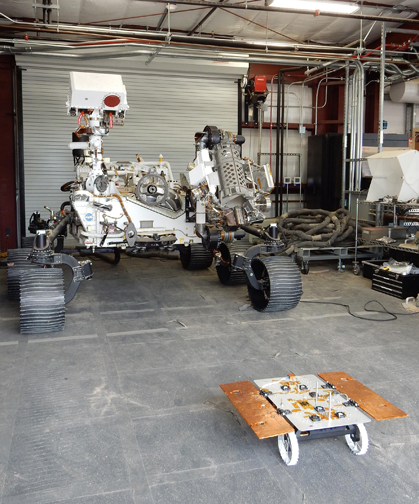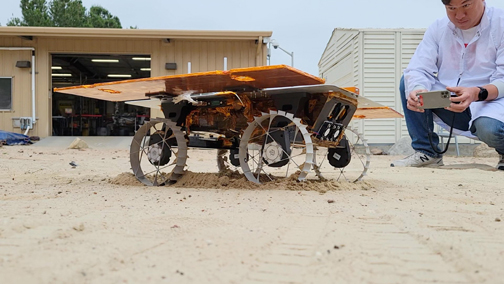Updated on Aug. 29 in bold

Image provided by NASA/JPL-Caltech
By Mary O’KEEFE
Next year the Cooperative Autonomous Distributed Robotic Exploration (CADRE) project, managed by Jet Propulsion Laboratory (JPL)/NASA, will attempt to do something on the Moon that is getting increasingly difficult on Earth: it will have three entities working together as a team toward one goal.
NASA will be sending three tiny robotic rovers to the Moon to see how well they can cooperate with one another without receiving input directly from mission controllers back on Earth. The project marks another step the agency is taking toward developing robots that, by operating autonomously, can boost the efficiency of future missions, according to a NASA statement.
“Autonomous” means the robots will be performing tasks independently. The interesting part of CADRE is that this independence will not be a just robot rolling along the lunar surface but three robots working together on their assigned tasks.
“We are trying to do something with technology for the first time,” said Jean-Pierre de la Croix, principal investigator of JPL’s CADRE. “It’s doing something with robots that are autonomous [but] are also working as a team.”
Humans on Earth will provide the three robots with “high level goals” to explore one area or another; then it is up them to figure out how that exploration will be done.
“We are also showing the capability for the future as a proof of concept, so we are focusing on something called a distributed measurement where each of the robots is carrying an instrument, a ground penetrating radar. They are going to operate this ground penetrating radar together to do a measurement that in the future could be used for science missions,” de la Croix said.
In this particular demonstration, the autonomous system will not decide all aspects of the mission.
“The autonomous system is not going to decide where things get done, or what gets done, [and] they are given a task by people on the ground,” he said.
The key part of the mission will be how these robots work as a team, how they autonomously work together to decide what each robot does to complete the mission or task that has been given them.
“We are trying to entrust the system to do more, not micromanaging the decisions of how to drive around obstacles or how to split up an area to explore. We are leaving that up to the team [of robots]. They have the necessary algorithms to do that correctly,” de la Croix added.
The robotic rovers will face several tests, all within view of a monitoring camera on the base station atop the lander. The first is to drive in formation and stay on course using ultra-wide band radios to maintain their relative positions while relying on sensors to avoid obstacles. In the second experiment the rovers will each take a path of their own choosing to explore a designated area of about 4,300 square feet, creating a topographic 3D map with stereo cameras, according to JPL/NASA.
The three-member robotic team will be blazing the trail for future missions – not just to the Moon but other space locations. The goal of CADRE is not to replace human exploration but to enhance it as scientists will still choose the areas to explore; however, the robots will actually collect information in the area. This can be a tool for human exploration.
“What I am focusing on is providing the key technology that would provide that [help] down the line; how people are actually going to execute [future missions] we will have to wait and see,” he said.
De la Croix added there are a few of things he and his team are hoping to learn from this mission/demonstration.
“[We are hoping to learn] it is possible to do this type of autonomous coordination with multiple robots. Our goal is to demonstrate this technology could be potentially used on other future missions. We want to make this part of the tool set that NASA looks at in terms of the next flight mission. We are also going to learn how to operate such a system and [to find] what is the humans’ role, what is the robots role and how does the flow of information work between the robot system and the people on the ground,” he said. “Lastly, we are also doing this demonstration with the ground penetrating radar. We are going to learn something about the possibility in doing the distributed measurements with this system and whether that opens up a new class of measurements that we could potentially perform on future missions.”

Image provided by NASA/JPL-Caltech
But the knowledge gained from this Moon mission will not just help space exploration, it could also have practical uses here on Earth.
“I think there are areas [that can be supported] that involve search and rescue being able to find [people or items] in the environment were you need multiple robots,” he said. “For example, when you are going into a cave system.”
The ground penetrating radar will also be useful for science exploration on Earth.
As you can probably tell, this type of multi-teamwork robotics is something de la Croix not only knows well but also gets excited about.
He got the “robotics bug” before high school and in college spent his undergrad time focusing on the studies of robotics, including joining robotics student competition teams. Eventually he started doing undergraduate research on multi-agent systems. This is using multiple robots – all working autonomously.
“I ended up liking that enough I did a PhD on it and then JPL hired me to do multi-agent robotics here. Eight years later [we] are bringing it to space,” he said. “It is sometimes surreal being able to say that something I was interested in so long ago is now going into space.”
The mission does not have an exact launch date but is scheduled for some time March 2024.
